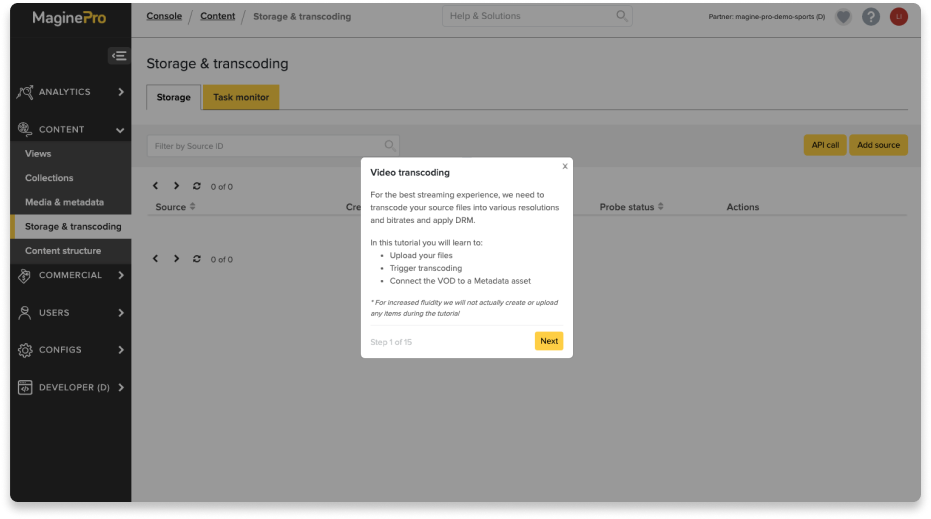Navigating a Seamless OTT Platform Switch: Lessons from a Recent Success

Understanding the Migration Landscape
For any OTT service provider, the need to migrate often arises because their existing platform can’t meet their growth requirements. There can be many sticking points that finally trigger the search for a new provider – from scalability and monetisation flexibility to the quality of the user experience. In the current climate, however, the main driver is definitely the desire to reach Smart TVs.
Big screen was certainly the priority for our most recent new customer, an OTT service based in Latin America. They made the switch to Magine Pro’s OTT platform because they wanted to capture a share of the booming market for streaming content on Connected TVs. Their first goal was to have apps on the market-leading devices – Samsung and LG – but also to have the scope to reach other brands of TV in the near future.
The biggest challenge in this project was the timescales. For their own business reasons, the customer wanted to go live with their new apps on the Magine Pro platform in under four weeks. Anyone who’s launched or migrated an OTT platform will know that’s a tall order, but it’s totally achievable with the Magine Pro platform, as we demonstrated by going live in 3.5 weeks! Here’s how we did it:
Start Strong: The Step-by-Step Approach to OTT Upgrades
My colleague Marcus Lindén has already blogged about some of the top technical considerations for any OTT service looking to switch platforms and offered his low-stress guide to getting it done. For me, the key to success in any customer engagement is great communication. This starts with our onboarding process where we outline:
- All the tasks involved
- Roles and responsibilities for both Magine Pro and the customer
- Where the customer can find how-to documentation
We’ve spent a lot of time optimising our customer-facing documentation so that everyone is clear on their roles and responsibilities within the project. The onboarding process also includes a full demonstration of the Magine Pro Console – our online tool that is used by our customers to manage the configuration of their apps and curate their content. Thankfully, the Console is super-easy to use, but it also includes in-app FAQs and help sections so our customers can get self-service support.
The Step-by-Step approach to a successful OTT Upgrade
In any migration process, there are some tasks that take longer than others. These typically include ingestion of content and getting app store approval from the Smart TV manufacturers. So, we always highlight the importance of starting on these tasks as soon as possible.
In the case of our recent client, they had a huge library of movies to upload, so I advised them on prioritising their “must-have” content for launch. By working on that first, they were ready to make the switch as soon as possible, leaving the longer-tail movies to be ingested after launch if necessary.
Regular Engagement: A Recipe for Success
It is possible to successfully move an OTT service to the Magine Pro platform with just the onboarding meeting and the provision of our documentation. However, with such a tight timeline, we agreed on a schedule of very regular internal and customer meetings to check in and ensure everyone was continuously aligned on the project. These sessions served as crucial touchpoints where progress was reviewed, challenges addressed in real-time, and next steps defined collaboratively.
You might be thinking that the customer needs to have a big technical team in place to manage their side of the process, but that couldn’t be further from the truth. In fact, our recent customer has just three full-time staff: two working on content and one on marketing. They were very responsive and engaged with the project and between them were able to hit all the deadlines required to make the timeline a reality.
Managing The App Store Approvals Process
With the various app stores, it’s the customer who owns the relationship with the likes of Apple, Google etc. so we can help, but we can’t do the whole process for them. For the recent customer, this was the first time they’d worked with LG and Samsung, so it was important to get their accounts created early in the process. While we create and test the apps, it’s the customer who has to submit them and all supporting promotional materials.
For the Smart TV companies, there’s the additional burden of creating a PowerPoint presentation that outlines how the app functions to support them in their approvals testing. We’ve done this many times before, so in our very first meeting to onboard the customer, I’ll outline the whole process with them and walk them through the different images, text, and documentation that will need to be uploaded through each app store.
One aspect of launching on Smart TVs that is familiar to us, but came as a surprise to our latest customer as it has many other OTT services, is the issue of backwards compatibility on older screens. Although our apps work well on older models of Connected TV, the manufacturers typically require a separate contract before they’ll release an app to devices launched in 2019 or earlier. This is, like the app store submission process itself, something we can advise on, but a process the customer must manage themselves. It’s another thing they need to work on as soon as possible to avoid any delays.
Getting Subscribers on Board: Reducing Friction To Mitigate Churn
The final step before the customer goes live on the Magine OTT platform is to migrate their user data across from their old platform. We’ve optimised our migration scripts for speed and efficiency. In our most recent project, we were able to transfer all the user data (with the exception of passwords) in around two hours which minimised the downtime for subscribers before we could get them going on the new apps.
The timing of this process is essential, but so is the way it’s communicated. Any kind of confusion or unexpected friction runs the risk of causing subscribers to churn. With our recent project, the customer took our advice to be very proactive in communicating with their subscribers about the upcoming change.
In addition to emails advising users of what was to come, they displayed banners in the existing apps that linked to a landing page which described what the migration process would look like. This was key in getting consumers ready to create their new passwords and explore the new, upgraded user experience. We also provided SEO optimization links that were added to their existing web pages. These ensure users are redirected to the new apps when Googling specific content.
Post-Migration Support and Optimisation
Of course, the initial transition is not the end of the story. Now that this customer is live on the Magine Pro OTT platform, there is still much work to be done. There are more Smart TV apps to be added in the future and further content to be uploaded.
Our Customer Success team continues to support them in the post-migration phase, assisting them with verifying configurations, optimising platform settings, and addressing any post-launch adjustments. This holistic approach ensures that our clients not only go live on time but also thrive in their new digital environment.
Looking Ahead: Lessons Learned and Future Readiness
Reflecting on this specific project, it’s clear that effective communication, meticulous planning, and agile execution are paramount when you’re looking to achieve both speed and quality. While each migration presents unique challenges, we are committed to delivering a seamless transition. If you’re contemplating a migration or seeking to optimise your current OTT setup, contact our experts to talk about your needs.

